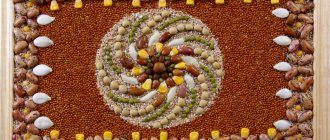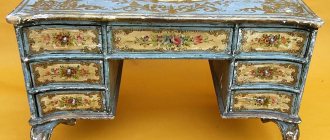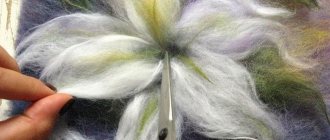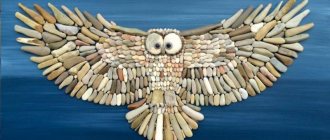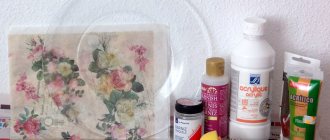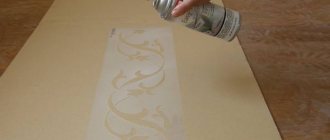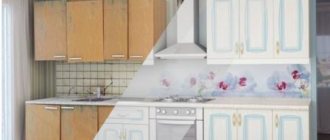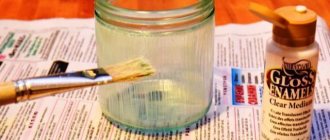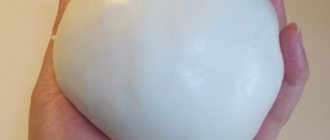You can easily and simply add a variety of intricate patterns to your interior using a special template, the so-called “stencil”.
The essence of the stencil is to transfer a pattern prepared in advance on sheet moisture-resistant material to a prepared, painted surface without wasting time on manual labor.
It is important to note that in this article we are considering stencils for interior decoration and interior elements, namely:
- stencils for wall decoration (stencils for ceiling decoration);
- stencils for mirror decoration (stencils for glass decoration);
- stencils for door decoration;
- stencils for furniture decoration.
The method of applying a pattern with a stencil makes it possible to complete it with perfectly precise contours and very quickly, without spending a lot of effort and without having the qualifications of a painter. You also do not need to have artistic skills in order to get a full-fledged multi-color drawing with elements of highlights, shadows and other details.
How ornament is used in design
Ornament is often called a designer’s assistant, which is not surprising: it unites surrounding objects into a single whole, sets the mood of the interior, and makes it noticeable. If you want to decorate your room with similar decor, think about the following things:
- Color balance of ornament and wall. The color for the pattern is selected taking into account the overall color palette and interior style. In calm versions, it repeats the shade of the wall, but differs by two or three tones, or is related. Sometimes the solution is based on contrast, but there may be restrictions on the application area.
- Environment. When choosing a pattern, take into account the surrounding objects: doors and windows located on the same wall, furniture (with upholstery) that overlaps the background. The combination of the entire set of shades should not tire or irritate.
Ornament on the bedroom wall Source jdmagicbox.com
- Application area. Not every pattern is suitable for application on all four walls. If it is bright, unusual, active in color, limit it to fragmentary use: on an accent wall, or even on part of it. A calm pattern, close in tone and lightness to the background, is suitable for global use.
- The small ornament fits harmoniously into the interior. To make a large pattern look complete, it is chosen based on the size of the room. The guideline is the size of the rapport (a single, repeating motif): the height should include at least 4-5 rapports, and it is highly desirable that they be whole.
Accent wall Source hardrawgathering.com
- If you plan to use several ornaments, a harmonious combination of colors is selected: one (sometimes two) unifying shade should be chosen, tying the composition into a single whole.
Lack of artistic skills cannot be an obstacle to painting on the walls. Stencil is a simple technology that is accessible to beginners and allows you to get high-quality results without excessive costs. The method impresses with its ease of reproduction and excellent results.
Eclectic Source pinimg.com
Stencil: variety of approaches
A stencil is a template that allows you to apply a design to a selected surface. Its main value is that it can be used to create a repeating pattern on any size wall area. You can make a template yourself, buy a ready-made one, or order an individual version from a printing house if you can’t find a suitable ready-made version.
Ready-made (purchased) stencils differ in several parameters. They are made from paint-resistant material; They are rigid and flexible, and according to the nature of application they are divided into two types:
- Disposable. May have several layers. They are made of thin silicone, have an adhesive base and are used for drawing multi-color compositions.
In the recreation area Source pinimg.com
- Reusable. Made from durable and more rigid material, intended for repeated use.
- According to the resulting effect, stencil images are divided into the following types:
- Single color. The ornament is applied in one color; No special skill is required from the performer; simple accuracy is sufficient. This method is the fastest, it is also suitable for obtaining silhouettes or inscriptions.
- Multicolor. The picture turns out to be multi-colored, with shades and transitions, but the work requires more accuracy. The image is applied in several stages, layer by layer; How many layers and stencils there will be depends on the number of colors.
Multicolor solution Source pinimg.com
- Volumetric. To create a three-dimensional pattern, putty is used. A layer of plastic material is applied according to the pattern in a layer of 1-3 mm. The three-dimensional design looks unusual, the relief surface attracts the eye. When the stencil is dry, you can make it more expressive by touching up the protruding parts.
- Anti-stencil (shadow image). In a regular stencil, paint is applied inside the boundaries of the repeat, but here they do the opposite: they paint over the space around the boundaries, simulating a blurred shadow (or highlighting effect) around the silhouette of the design.
There is an alternative method of transferring patterns to the wall: you can draw using a decorative roller. On its rubber surface there is a convex pattern of varying degrees of complexity, which is printed on the wall. Everything is much simpler here: all you have to do is choose the paint (the image will be one color) and prepare the surface. There is also nothing complicated in drawing: the decor is applied using a standard movement.
Applying a pattern with a roller Source blogspot.com
How to decorate a wall with a multicolor pattern using a stencil?
Below we describe how to use a stencil to decorate a wall with several colors at once. When applying a multicolor pattern, not one, but several stencils are used and the following technique is used. First you need to apply the background paint and wait for it to dry completely. Then, in turn, different parts of the stencil are applied and painted with certain colors. The colors should not overlap each other. A slight overlap is allowed, which often looks unsightly, so the combination of paints is tested in advance on plywood or plasterboard. It is not necessary to transfer the entire drawing - just see how the places where the colors overlap will look.
Paint each color with a separate brush. You can use one tool, but then you will have to thoroughly clean it every time. Do not start applying the next color until the previous one has dried. If, when applying a pattern through a stencil, there are unfilled areas, they can be corrected separately using a thin brush.
If the stencil is planned to be used repeatedly (the pattern is repeated several times), it should be washed after every 2-3 applications of paint.
If oil paint was used, a suitable solvent is used for cleaning, and ordinary water is suitable for washing off acrylic paint.
After the work is completed, the stencil is thoroughly washed and dried. If it has been stored for a long time, it must be cleaned of paint residues, dried and placed unfolded under the load.
Drawings on walls were made long before our era. Hundreds of years later, rock paintings make the “interior” of caves not only attractive, but also unique.
Nothing has changed. Well-chosen and properly executed wall painting will help transform the room.
A stencil print on the wall is an easy way to achieve the required zoning of space. By making small changes, you can hide the disadvantages of the layout or, conversely, draw attention to the advantages.
The execution of this painting can be either very complex or very simple. The difficulty of the work is largely determined by the chosen execution technique, the size and number of details in the outline. You need to figure out what is right for your home.
Types of stencils
Stencils help out when applying repeating complex motifs, successfully replacing manual labor. Ready-made kits differ in their scope of application, and it is useful to understand their diversity in order to choose the appropriate option. The following types of templates are common:
- Simple. The most budget-friendly sets, with a set of simple elements for decoration. They are suitable if you want to depict something simple on the wall. As a rule, the set contains reusable templates of the same size (for example, A4 or A3).
- Wallpaper stencils. They help create an imitation of wall wallpaper. The pattern is combined with itself in two ways: by repeating the pattern or by special alignment marks. The possibilities are varied: from painting flowers on the wall to abstract patterns, intricate ligature of oriental (for example, Indian) ornaments, classical curls and monograms.
Stencil with imitation wallpaper Source plentymarkets.com
See also: Catalog of companies that specialize in finishing materials and related work
- Border stencils. Reusable templates come in a variety of designs. Popular options include classic and ethnic patterns. You can purchase a design with a marine or children's theme, with objects, plants or animals. The set marked “Volume” is suitable for use not only for painting, but also for textured plaster (for liquid wallpaper).
- Angular. Corner elements help to design any rectangular surface: not only walls, but also ceilings, mirrors, furniture, doors. Using four repetitions of one rapport, you can depict a frame or medallion. Corner patterns reproduce different designs: from modern and classic, to abstract and ethno.
Original design Source pinimg.com
- Round. The template can be made in the form of a circle or an ornament that fits into a circle. Round elements are used to decorate a medallion, ceiling decor (under a chandelier) or a watch dial. Sometimes the template is a quarter of the image. If it is reusable, then it is used 4 times to get a complete drawing. If it is disposable, you need to purchase 4 pieces.
Round ornament Source pinimg.com
Advantages and disadvantages of DIY stencils
The widespread use of stencils is due to their special advantages:
- using one type of pattern you can create an entire composition on the wall;
- combinations of shades are used;
- ease of use and availability of a large number of pattern options;
- non-standard decoration of walls and furniture;
- templates are used for any surface, regardless of structure and texture;
- Using samples for painting, minor cosmetic repairs are carried out, since covering the wall with ornaments greatly changes the appearance of the room.
Templates are used not only for decorating, but also for creating a variety of postcards, collages and posters. A stencil is necessary for a variety of decorative works. It helps create original space, volume and depth, and also serves as inspiration for creativity. This is a budget-friendly way to bring something beautiful into your home without spending money.
Did you like the post?
Support us and share with your friends
And if you don’t like using widely replicated templates, you can make a stencil with an individual design yourself - this way you’ll get a unique ornament.
Popular varieties
The following stencil styles are popular:
- In the Art Nouveau, Art Deco and Art Nouveau style: all kinds of borders and panels depicting birds, fish and animals, floral and floral patterns. White patterns on dark-colored walls always look stylish.
- To decorate modern interiors, abstract motifs are chosen: combinations of figures, optical illusions, chevron patterns.
- For connoisseurs of oriental and eclectic styles, options with Arabic script based on medieval geometric compositions will be useful.
In retro style Source prosto-remont.net
Among specific images, the following templates are most often chosen:
- Turkish cucumber, also known as Turkish bean. The pattern, whose homeland is considered to be India or Persia, has become entrenched in European culture under the name “paisley”. Traditionally used in wall decoration and gives the room a touch of mystery.
- Damascus. Symmetrically arranged flowing floral and plant motifs have been known since the early Middle Ages and symbolize the luxury and impeccable taste of the owners of the house. The damask pattern is found in classical interiors (Baroque, neoclassical, Empire), including in the English style.
The main thing is the accuracy of application Source j.etagi.com
- Quatrefoil. A symmetrical pattern symbolizing clover; refers to traditional European symbolism. It consists of four overlapping circles and very vaguely resembles a plant. The pattern organizes the space, and in modern interiors it is used in doses. In elegant classic and retro interiors it can be used to the maximum.
- Chevron. A fashionable print, also known as herringbone. Actively used since the middle of the last century. If the interior is designed in a neutral color palette, the chevron can serve to create an accent wall.
Chevron Source icypohod.rf
Stylistics
To decorate walls in your preferred style, purchase stencil templates made in various directions. The most popular today:
Antique
If the entrance is quite large and has a rectangular shape, this design will suit it perfectly. Here you can use stencils in the form of monumental images:
- columns;
- statues;
- porticoes;
- vases;
- mythological stories and gods.
Art Deco
This decorative art of the first half of the 20th century brought with it luxury, severity and chic. It's hard to imagine it in the front door, but the result exceeds all expectations. The room is transformed, looks expensive and status - of course, provided that before that it was renovated and well-maintained.
Classics of the genre are images of galloping deer, stylized wings and geometric borders.
Japanese
It can be described as “serene unpretentiousness.” Worshiping the beauty of nature, the inhabitants of the land of the rising sun bring a piece of it into their home. The walls of the entrance are decorated with images of traditional plants - sakura, bonsai, bamboo, phalaenopsis, dracaena. You can add here hieroglyphs that have a certain meaning, drawings of pagodas and animals. The color scheme is dominated by neutral shades - brown and green.
Floral
To create it, images of various flowering plants, made in bright colors, are used. This is a great way to liven up any room.
Animalistic
By choosing this particular print, you can be sure that the entrance will no longer be boring. After all, there are practically no people who don’t like animals. Some people like birds, some like predators, some like reptiles. A good design decision would be to choose a motif that resembles or depicts representatives of the animal world.
Oriental
In the minds of most people, it includes exoticism, bright colors, and dance motifs. It contains a large number of ornaments and geometric patterns. Preference is given to gold, silver shades, as well as brown, orange, and brick.
How to choose an ornament
If there are no clear recommendations for choosing a location, then with templates the situation is simpler. The pattern is selected based on the overall style of the room, and it is useful to adhere to the following recommendations:
- Do not combine different types of ornaments. If you choose a damask ornament, you should not “improve” it with butterflies - the combination will turn out so-so, and the damask will lose its charm.
- Don't get carried away with decoration. If you are not sure how an overly detailed drawing will look, opt for a more concise option.
- Do not try to use mats with excessively small details. Firstly, they are not easy to paint neatly. Secondly, small fragments ultimately worsen the impression, since from a distance they resemble spots.
- Pictures that have a lot of jumpers look more beautiful, that is, all the details of the image are interconnected.
Stylized four-leaf clover Source inmyroom.ru
General recommendations
There are requirements for the choice of clichés that you should adhere to when planning to decorate the entrance with a pattern. Thus, it is not recommended to use many different elements, as a result of which the lines of the image will merge and it will lose its attractiveness.
An essential condition when superimposing an image is conciseness and clarity. In one room only a single type of ornament is used.
Try not to mix floral and geometric designs. Also avoid types of stencils with small details, so as not to get a stain that spreads across the surface. Prints with large lines and jumpers look advantageous.
Painting materials with a decorative effect are becoming increasingly popular:
Fluorescent
Using them in conjunction with stencils, you can achieve the illusion of glowing in the dark designs or flickering images that appear only at night.
Mother of pearl
Suitable for flower arrangements that will softly shimmer.
Velvet
Using velor paint, you achieve an even and durable coating. It helps hide flaws and unevenness in the walls. This paint is most often used with art deco style patterns.
Wall painting: where to start
Stencil painting is a quick and high-quality way to decorate walls. But before you get to work, you need to take care of the following things:
- Prepare the surface. The stencil technique can be performed on any clean surface. The wall is cleaned of dust and dirt, and if possible, vacuumed or washed. If the base is wallpaper for painting, you can do without cleaning.
- Stock up on levels. It will help to apply vertical and horizontal marks and will prevent the drawing from deviating from its intended position.
- Prepare tools. You will need 2-3 brushes of different sizes, a roller or sponge. Spray adhesive will be useful; it will help firmly fix the stencil on the wall.
Volumetric stencil Source decoratorist.com
- Choose paint. The choice is quite varied. Acrylic or tempera paints are suitable for work; you can use regular gouache or a can of spray paint (if you have similar experience).
Beginners who do not know how to paint on a wall are advised to use a brush with caution. Excess paint from its tip can get under the stencil and ruin the design. The spray works faster and the paint layer is more even.
It is also better to choose moisture-resistant paints of medium consistency for work, then the image will be more durable. If you have not worked with stencil technology before, limit the number of colors to three.
Three-color decor Source walldecorbangalore.com
Pattern application technology
In order for the paint to lay on the surface successfully and not spread, it is important to choose the right technique with which the drawing will be applied. There are several basic techniques:
- pattern using one color. In this case, the result will be a monochrome drawing;
- multi-color combined palette. Several different colors are used here, but more time and patience is spent drying the different layers of paint. This method is suitable for more experienced decorators who have already worked using the monochrome method;
- holographic or volumetric method. Here they use putty, which is applied with a special spatula. This way you can achieve a “velvet” effect and some image thickness (1-3 millimeters), which even creates the appearance of a three-dimensional image.
Helpful advice: if the putty layer is not laid down very evenly, you can use sandpaper to form a neat edge, wiping off excess paint around the image.
- reverse stencil. If in the usual case the paint is applied inside the slots, then using a reverse stencil the opposite result is achieved - the paint covers the space outside the boundaries of the design. Due to this technique, it seems as if the drawing emits a slight glow. It is usually convenient to take paint in cans here. In the process of work, they use a cutting - part of the template, which will then be thrown away. It is glued to a wall or other surface, sprayed with paint.
Choosing a place to place the picture
In general, the territory for the template is not limited in any way. But to achieve the maximum decorative effect, you can use traditional techniques. Most often, a large, spacious plane, empty and free of furniture, is used to apply a template design. A large and bright stencil is chosen for it, which will create an attractive pattern - it will help to play up the atmosphere in an interesting way and add color to the atmosphere of the room.
Helpful advice: you shouldn’t take a modest, small picture for a large and empty wall - it looks stingy and poor. A stencil that is too large will look bad on a small wall, where the space will look cramped and out of proportion.
A good way is to play with humor on existing furniture using a stencil. Above the table you can draw a vase, rosette or candle in a candelabra, as if they were on the tabletop. Above the shelf, an interesting idea would be to depict the spines of books or silhouettes of figurines.
Tools for creating a template
The available set of items will be a useful set for creating a stencil:
- selected image;
- suitable material - from cardboard and plastic to photographic paper, sometimes lavsan is used;
- "carbon copy";
- pencils, felt-tip pens, markers (can be in one copy);
- paper knife or scalpel;
- masking tape and regular, transparent tape;
- draft paper for experiments;
- a wooden board (or other material) that you don’t mind cutting out a template on it.
Helpful advice: before the crucial moment of drawing a drawing “white”, it is better to practice on a piece of paper, also checking the optimal combination of colors and the degree of fluidity of the paint.
Cutting a stencil
The selected drawing must be transferred to the template base using carbon paper. If the base is plexiglass or plastic, then a marker is enough to outline the outline of the design. When copying, the image moves along the base, so it is better to fix its position with tape. Then cut holes for the paint using a sharp utility knife or scalpel. Remove layers of paper inside the outlines of the design. To make this work as efficiently as possible, it is better to perform this work on a hard surface that can withstand movement with the blade - a cutting board or unnecessary covering, a piece of linoleum.
Drawing
After this, they begin to apply the image to the wall or door. It is important to thoroughly clean the surface and dry it from excess moisture or greasy stains (otherwise the paint will spread and not stick). Make marks in the places where the drawing will be placed - use a tape measure or ruler. The cut out template is attached to the surface with tape or glue in the form of a spray. The aerosol type of glue will not tear off a piece of wall, wallpaper or paint when removing the template, moreover, it is invisible and does not leave marks. Paint the stencil using a brush or sponge. Take a little bit of paint so that it does not spread under the stencil layer. A convenient way to hold the brush is perpendicular to the wall, applying paint with light strokes of the swab. When painting small parts, it is better to use an up and down application technique. If an aerosol can is used, keep it at least 30 centimeters away from the wall. It is better to first blot the sponge on a piece of paper, removing excess paint. If you are making a large-scale drawing using a roller, you will have to slightly adjust the drawing by painting on small details and strokes after removing the stencil. Having finished painting, the stencil is carefully removed, being careful not to damage the image. The result is dried for some time.
An original design solution would be to create dynamic compositions, with a sense of humor or interesting inclusions. Depict a group of animals in motion or a collage of exotic plants or birds. The choice of paints is individual, but acrylic is more often used due to its cheapness, practicality, and environmental composition. Acrylic paints do not fade; they are often used as part of a decorative type of plaster, which allows you to create very beautiful bas-reliefs. If we are talking about a diverse stencil, the ideal solution would be to use a self-adhesive film - it is easy to apply and remove, and helps to achieve a tight fit to the surface.
Home decoration is one of the techniques for creating an unforgettable and cozy atmosphere in your home. The application is in demand. You can make stencils for decoration with your own hands. Templates can be found on the Internet. Such images are simple and concise; they are suitable for decorating walls, mirrors and even windows. Various templates allow you to highlight one zone and do not overload the space. A correctly selected pattern or pattern will highlight the overall design of the home and create a special atmosphere.
Using this technique, you can create a unique and stylish decor.
Read in the article
How to make a template
Making a template is a simple process, but in order for the result to be of high quality, the following subtleties must be taken into account:
- Use a material that is suitable for its characteristics: thick paper (for disposable matrices), cardboard or flexible transparent plastic that can fit tightly to the wall (for example, an A4 plastic folder is suitable).
In black and white palette Source yandex.net
What to watch out for when applying ornaments
The process of applying the design is not difficult, but during work you need to remember the following subtleties:
- It is more convenient to attach a template (especially a large one) to the wall with tape, construction tape or special glue.
- After applying one pattern, the template is carefully wiped so as not to spoil the work.
Working with a roller Source archidea.com.ua
- Apply a little paint to the brush. The best method of application is by stuffing, then the paint will not get under the plastic. Excess paint is removed from the sponge by doing a test on an unnecessary sheet of paper.
- When working with a roller, make sure that the paint is applied evenly, especially where the parts are small. When using a spray can, you need to make sure that the colorful aerosol does not get over the edge of the template.
- The stencil is removed immediately after painting, without waiting for the paint to dry.
- If the image is multi-colored, a new shade is applied after the previous one has dried.
Applying paint with a brush Source uiut.boltai.com
Paint Application Tools
Acrylic paint, which is used in decoupage, when applied with a brush, can be applied in accordance with its shape - thin relief stripes. You can avoid their appearance on the work surface by using pressure tools:
• Stencil brush – round, voluminous, with perfectly even bristles, it is used for “driving in” paint. In this case, an important condition is a moderate amount of paint on it. Therefore, before starting work, you should tap it on the palette, lightly spread it on paper or a napkin, and knock off excess paint.
• Foam sponge. You can find it not only on the virtual shelves of our store in the form of a brush with a handle, but also in the kitchen in the form of a regular dishwashing sponge. It picks up paint well and releases it in small portions, thanks to which, by first knocking off the excess, the pattern turns out uniform and neat.
• Foam roller. It is used mainly on large surfaces, and the severity of the pattern is directly related to the pressure applied and the amount of paint in it. To avoid unevenness, it should be rolled several times on a sheet of paper before work.
Stencil technology allows you to create attractive designs, backgrounds and borders not only with paint, but also with other compositions. In our store you can purchase voluminous materials to complement your works with original relief motifs.
Briefly about the main thing
A stencil is an affordable way to create an unusual, eye-catching interior. To ensure a harmonious result, take into account the relationship between a single element and the area of application, as well as color and stylistic balance.
According to the method of use, stencils are divided into single- and reusable, and ready-made stencil designs are single- and multi-color, as well as three-dimensional. The design of the patterns is varied and allows you to choose the desired image for both classic and modern styles, as well as for various details (corner, border).
The template can be purchased ready-made or made independently; You will need cardboard or plastic. It is convenient to apply patterns with a brush, roller, sponge or spray from a can; At the same time, accuracy and knowledge of some subtleties are important.
Ratings 0
What are stencil designs?
Do-it-yourself decorative stencils are templates that are made on durable cardboard or a metal sheet. The pattern elements are distributed onto the surface of the material, and then the marked parts are cut out and form holes. In the future, these areas will be painted in.
Stencils can be multi-layered or single-layered. The latter are performed in one template overlay. Multi-layered options are often used in street art. Different types of paints are used for painting: acrylic, enamels and water-based.
Stencils can be multi-layered or single-layered. The latter are performed in one template overlay. Multi-layered options are often used in street art.
A comment
Designer of the studio "Cozy House"
Ask a Question
